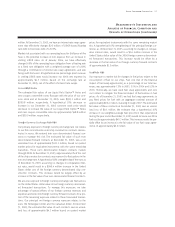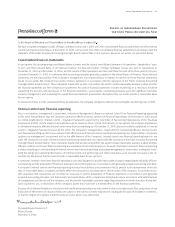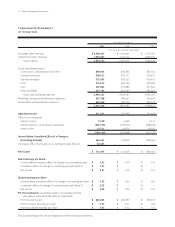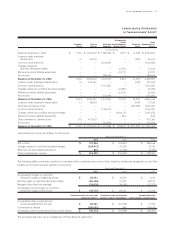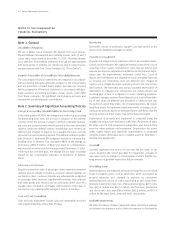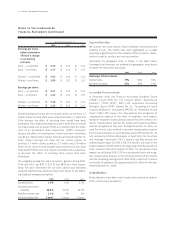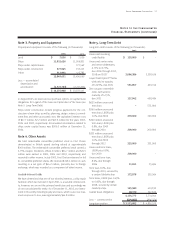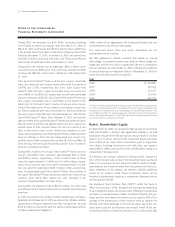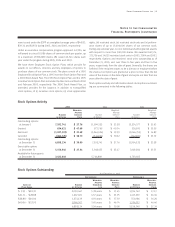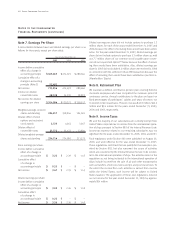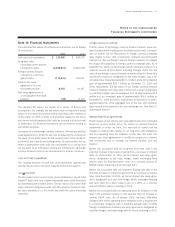Royal Caribbean Cruise Lines 2005 Annual Report Download - page 36
Download and view the complete annual report
Please find page 36 of the 2005 Royal Caribbean Cruise Lines annual report below. You can navigate through the pages in the report by either clicking on the pages listed below, or by using the keyword search tool below to find specific information within the annual report.
Note 1. General
We are a global cruise company. We operate two cruise brands,
Royal Caribbean International and Celebrity Cruises, with 19 and 9
cruise ships, respectively, at December 31, 2005. Our ships operate
on a selection of worldwide itineraries that call on approximately
200 destinations. In addition, we charter one ship to Island Cruises,
our joint venture with First Choice Holidays PLC (“First Choice”).
The consolidated financial statements are prepared in accordance
with accounting principles generally accepted in the United States
and are presented in United States dollars. Estimates are required
for the preparation of financial statements in accordance with gen-
erally accepted accounting principles. Actual results could differ
from these estimates. All significant intercompany accounts and
transactions are eliminated in consolidation.
Note 2. Summary of Significant Accounting Policies
In the third quarter of 2005, we changed our method of accounting
for drydocking costs from the accrual in advance to the deferral
method. Under the accrual in advance method, estimated drydock-
ing costs are accrued evenly over the period to the next scheduled
drydock. Under the deferral method, drydocking costs incurred are
deferred and charged to expense on a straight-line basis over the
period to the next scheduled drydock. The deferral method is prefer-
able because it eliminates the judgment needed to estimate dry-
docking costs in advance. The cumulative effect of the change on
prior years of $52.5 million, or $0.22 per share on a diluted basis,
was included in net income for the year ended December 31, 2005.
Other than this one-time gain, the change did not have a material
impact on our consolidated statement of operations or balance
sheet.
Deposits received on sales of passenger cruises represent unearned
revenue and are initially recorded as customer deposit liabilities on
our balance sheet. Customer deposits are subsequently recognized
as passenger ticket revenues, together with revenues from onboard
and other goods and services and all associated direct costs of a
voyage, upon completion of voyages with durations of ten days or
less and on a pro rata basis for voyages in excess of ten days.
Cash and cash equivalents include cash and marketable securities
with original maturities of less than 90 days.
Inventories consist of provisions, supplies and fuel carried at the
lower of cost (weighted-average) or market.
Property and equipment are stated at cost less accumulated depre-
ciation and amortization. We capitalize interest as part of the cost of
acquiring certain assets. Improvement costs that we believe add
value to our ships are capitalized as additions to the ship and depre-
ciated over the improvements’ estimated useful lives. Costs of
repairs and maintenance are charged to cruise operating expenses
as incurred and drydocking costs are deferred and charged to
expense on a straight-line basis over the period to the next sched-
uled drydock. The estimated cost and accumulated depreciation of
refurbished or replaced ship components are written-off and any
resulting gain or loss is recognized in cruise operating expenses.
Liquidated damages received from shipyards as a result of late deliv-
ery of new ships are deferred and amortized in other income over
the period to which they relate, net of related expenses. We review
long-lived assets for impairment whenever events or changes in cir-
cumstances indicate, based on estimated future cash flows, that the
carrying amount of these assets may not be fully recoverable.
Depreciation of property and equipment is computed using the
straight-line method over estimated useful lives of primarily 30 years
for ships, net of a 15% projected residual value, and three to forty
years for other property and equipment. Depreciation for assets
under capital leases and leasehold improvements is computed
using the shorter of the lease term or related asset life. (See Note 3.
Property and Equipment.
)
Goodwill represents the excess of cost over the fair value of net
assets acquired. We review goodwill for impairment annually or
whenever events or changes in circumstances indicate that the car-
rying amount of goodwill may not be fully recoverable.
Advertising costs are expensed as incurred except those costs which
result in tangible assets, such as brochures, which are treated as
prepaid expenses and charged to expense as consumed.
Advertising costs consist of media advertising as well as brochure,
production and direct mail costs. Media advertising was $139.1 mil-
lion, $133.2 million and $119.2 million, and brochure, production
and direct mail costs were $86.9 million, $82.2 million and $73.5
million for the years 2005, 2004 and 2003, respectively.
We enter into various forward, swap and option contracts to manage
our interest rate exposure and to limit our exposure to fluctuations
34 Royal Caribbean Cruises Ltd.
Notes to the Consolidated
Financial Statements





